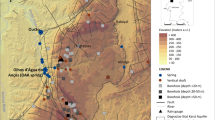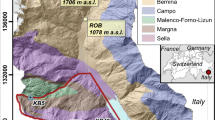Abstract
The complex functioning of karst systems depends on several factors (e.g., geology, karstification status, climate) which influence flow conditions. Understanding a system requires monitoring that includes a sampling interval well adapted to the system's size, and the use of hydrodynamic and geochemical approaches. From our own observations, the general physical and geochemical characteristics of the aquifers are perennial and representative of karst evolution at a given moment. The Notre-Dame-des-Anges karst system, which is situated in France on the rim of the Vaucluse karst region, was studied during 2 water years. This study demonstrates that several parameters are not definitive, and that they do not provide information about the actual status of the karst evolution of the system. We were able to observe that hydrological parameters in particular are dependent on the configuration of the outlets, which can dramatically change. For example, a heavy storm (300 mm of rain in 4 h), which occurred in the intake area on 22 September 1992, produced a piston effect in the aquifer, which was expressed by extensive unclogging of the whole aquifer. The appearance of a new gryphon at the outlet induced a change in the flow rate and added to the unclogging.
The other major result of this study is the demonstration of intensive, even preponderant, participation of water originating in the infiltration zone in the behavior of the system. This contribution, often minimized in previous studies, is closely dependent upon flow conditions and especially upon the recharge status of the infiltration zone. Physical and chemical parameters allowed us to trace this water, and to demonstrate the existence of an actual hanging reserve which plays not a negligible part in flow, during both high and low water levels.
This paper demonstrates the necessity of coupling a hydrodynamic study with a hydrochemical approach, and of questioning the representativeness of parameters during a given period, for a better understanding of the functioning of the karst system. This is especially true if the infiltration zone of the karst system is heavily developed, and if external factors (e.g., river, landslip, clogging) influence the outlet
Similar content being viewed by others
Author information
Authors and Affiliations
Additional information
Received: 10 June 1996 / Accepted: 11 November 1996
Rights and permissions
About this article
Cite this article
Lastennet, R., Mudry, J. Role of karstification and rainfall in the behavior of a heterogeneous karst system. Environmental Geology 32, 114–123 (1997). https://doi.org/10.1007/s002540050200
Issue Date:
DOI: https://doi.org/10.1007/s002540050200




